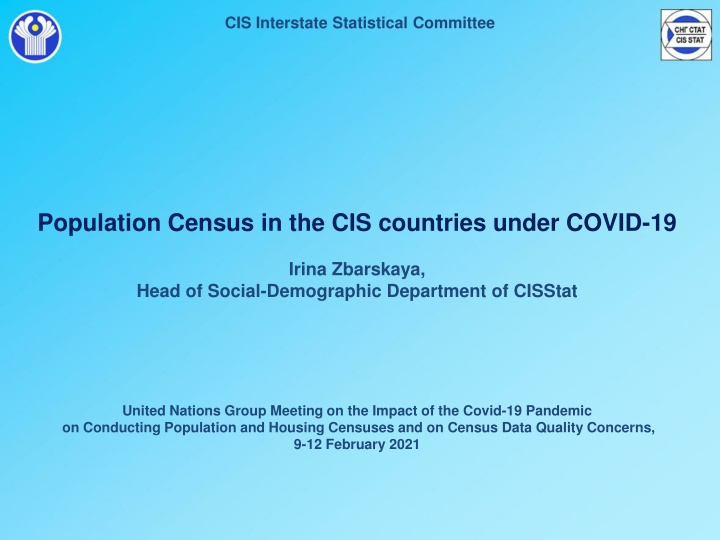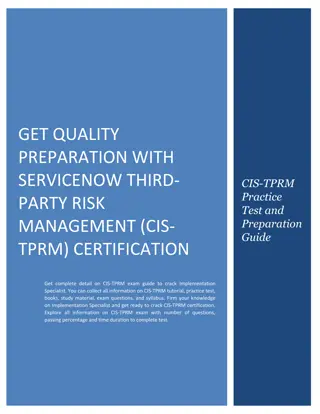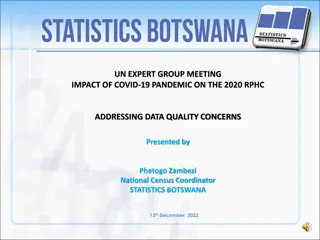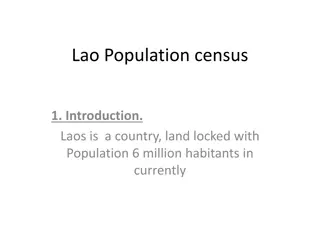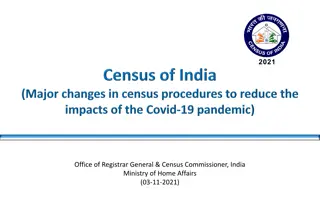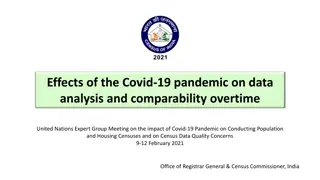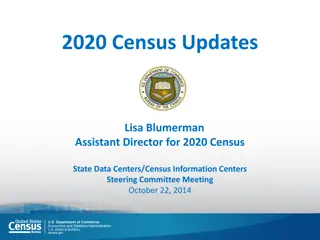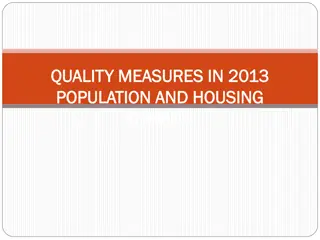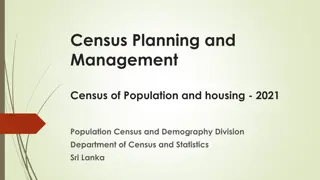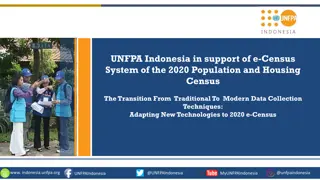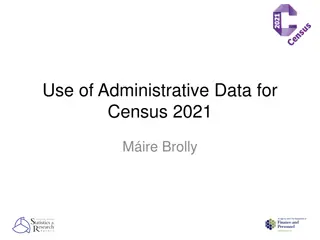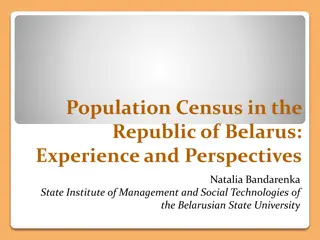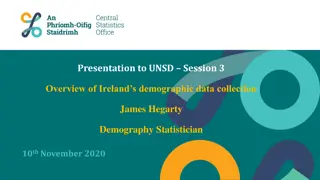Population Census Methods and Quality Control in the CIS Region under COVID-19
The Population Census in the CIS countries faced challenges due to COVID-19, leading to a shift in census methods from traditional face-to-face interviews to online and multiple technical means. Quality control measures were implemented to avoid double counting, ensuring complete population registration. The use of various methods and technologies aimed to enhance the accuracy and efficiency of census data collection.
Uploaded on Sep 16, 2024 | 3 Views
Download Presentation

Please find below an Image/Link to download the presentation.
The content on the website is provided AS IS for your information and personal use only. It may not be sold, licensed, or shared on other websites without obtaining consent from the author.If you encounter any issues during the download, it is possible that the publisher has removed the file from their server.
You are allowed to download the files provided on this website for personal or commercial use, subject to the condition that they are used lawfully. All files are the property of their respective owners.
The content on the website is provided AS IS for your information and personal use only. It may not be sold, licensed, or shared on other websites without obtaining consent from the author.
E N D
Presentation Transcript
CIS Interstate Statistical Committee Population Census in the CIS countries under COVID-19 Irina Zbarskaya, Head of Social-Demographic Department of CISStat United Nations Group Meeting on the Impact of the Covid-19 Pandemic on Conducting Population and Housing Censuses and on Census Data Quality Concerns, 9-12 February 2021
Population censuses in the CIS region 2019 2020 2021 2022 2023 KYRGYZSTAN ? MOLDOVA APR. AZERBAIJAN 1-10 OCT. KYRGYZSTAN 23 MAR. 1 APR. KAZAKHSTAN 1-30 OKT. TURKMENISTAN 17-27 DEC. KAZAKHSTAN 1-30 OKT. BELARUS 4-30 OCT. UZBEKISTAN 1-25 NOV. UZBEKISTAN 1-25 NOV. RUSSIA 1-30 APR. UKRAINE ? RUSSIA 1-31 OKT. ARMENIA 14-23 . ARMENIA 18-27 OKT. TAJIKISTAN 1-15 OKT. 2
Census methods (1) 2010 Personal interviews using paper questionnaires 2020 Personal interviews using: Self-report online census Administrative data/register paper electronic devices questionnaires AZERBAIJAN ARMENIA BELARUS KAZAKHSTAN KYRGYZSTAN MOLDOVA RUSSIA TAJIKISTAN UZBEKISTAN UKRAINE 100% 76% 22% 2% 100% - - 3
Census methods (2) Important difference between the 2020 round of censuses and the previous round transition from the traditional census model face to face and filling out paper questionnaires to: a multiplicity of methods - survey and self-filling via the Internet and a multiplicity of technical means - paper and electronic questionnaires. the census model becomes more complex, several technological lines appear, there is a need to combine different data sets and the importance of quality control of the census increases 4
Main methods of quality census data (1): and to avoid double counting of the population. his should be ensured at all stages of the census: pre-census procedures, field work, processing and receiving results It is important to ensure that the population is fully accounted for During the census period: in countries that intend to use online censuses and face to face method special automated control procedures are being developed to get information about the number of people who have passed the census via the Internet. Such control will allow to avoid double counting and admissions of the population. The duration of the Internet census is shorter than the duration of the entire census. sample control visit of 10% of households. The completeness of the population registration and the correctness of filling in the census forms are checked. The survey is conducted by the supervisor together with the interviewer of this enumeration unit (most countries) in 3-5 days after the end of the main census period. 5
Main methods of quality census data (2): During processing, generating results, and after the census : Comparison of census results with the data of the current statistics. Application of methods of demographic analysis at the census. Comparison of census results with data from registers and administrative sources. Post enumeration survey (PES): Moldova -2014 and Belarus -2019. 6
Duration and burden Duration of censuses Average number of persons per 1 interviewer 2010 2010 2020 2020 300 AZERBAIJAN 10 10 11 10 10 14 12 10 12 - - 10 10 27 30 10 450 380/320* 750 833 300/250* ARMENIA 320/270* 250 300/350* 400 300/350* 400 350/400* BELARUS KAZAKHSTAN KYRGYZSTAN MOLDOVA 550 RUSSIA 30 15 TAJIKISTAN 650(e) 380(p) 320/350* 350 TURKMENISTAN UZBEKISTAN 25 UKRAINE *Urban/rural 7
Impact of COVID-19 on population censuses Possible changes: number of persons per 1 interviewer census program census method training program salary information campaign funding AZERBAIJAN no no yes yes ARMENIA no no no BELARUS yes yes yes KAZAKHSTAN no no no no no no yes yes KYRGYZSTAN no no yes MOLDOVA RUSSIA no no no no no no no TAJIKISTAN UZBEKISTAN UKRAINE 8
Key points Round 2020 will be a turning point in the CIS region in terms of methods of obtaining information from the population: in most countries a combination of census methods will be used - population survey and self-completion of questionnaires by Internet; information about the majority of the population of the CIS will be generated directly in electronic forms. It should speed up the processing of census materials and make it safer from the COVID. A number of countries that plan to conduct a census this year have stated that some changes will be made to the census program, the training program and the salary of census staff, the information campaign, which will require additional financial resources. No additional data quality control measures will be applied. ensus staff will be provided with personal protective equipment (masks, sanitizers, etc.) and will be given the opportunity to get vaccinated against COVID (voluntarily). 9
Thank you for attention! CIS Interstate Statistical Committee (CIS-STAT) http://www.cisstat.org
